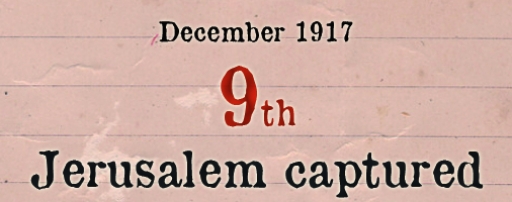Jerusalem fell to British-led forces on 9 December 1917 with their commander, General Sir Edmund Allenby, formally entering the Holy City on foot two days later. Major Paul Knight explains how Prime Minister Lloyd George’s “Christmas present for the British people” was delivered at the end of another inconclusive year in the First World War.
By the end of 31 October 1917, General Allenby’s Egyptian Expeditionary Force (EEF) had broken through the Ottoman defences at both Gaza and Beersheba. The road to Jerusalem was now open as was the prospect of fulfilling British Prime Minister David Lloyd George’s expectation that Jerusalem would be captured in time to become a Christmas present to the war weary populace. Despite a number of successes that year – Baghdad, Vimy Ridge, Messines, Beersheba – 1917 was not an unqualified success. Third Ypres struggled in the Flanders mud while the initial promise of Cambrai had not been fulfilled.
The EEF’s dispositions placed the XXI Corps on the coast at Gaza and both the XX Corps and Desert Mounted Corps inland at Beersheba. It was this latter force, especially the infantry of XX Corps, who would drive on to Jerusalem.
The Coastal Route
The Ottoman defenders evacuated Gaza on November 5, which allowed Lieutenant-General Bulfin’s XXI Corps to advance along the coast towards Jaffa. Bulfin’s Corps consisted of two divisions of British Territorials, 52nd (Lowland) and 54th (East Anglian), and 75th Division which was a mix of English Territorials and Indian battalions. The Territorials were raised in 1908 under the Haldane Reforms for Home Defence but now found themselves a long way from home.
The coastal route initially appeared to be the most advantageous. The coastal plain was flat while Allied domination of the Mediterranean allowed warships to protect Bulfin’s left flank while also providing naval gunfire support against Ottoman opposition. Meanwhile, supplies could be unloaded at captured ports, easing the logistical burden on the land routes.
Ottoman defences around Junction Station were attacked on November 13. This position lay west of Jerusalem and its capture by Bulfin both opened the way to Jaffa on the coast and secured the west flank for XX Corps’ advance on Jerusalem.
The Judean Hills Route
Lieutenant General Chetwode’s XX Corps also consisted mostly of British Territorial divisions – 53rd (Welsh), 60th (2/2nd London) and 74th (Yeomanry) which was largely composed of dismounted Yeomanry units. The final division, 10th (Irish), was a New Army formation composed of Regular or New Army Irish battalions.
Lieutenant General Chauvel’s Desert Mounted Corps consisted of the Australian and New Zealand Mounted Division, and the British Yeomanry Mounted Division.
The most direct route to Jerusalem ran along a single road from Beersheba through Hebron and Bethlehem. 53rd Division would capture Hebron and Bethlehem. This route ran into the Judean Hills and with the approach of winter, thunderstorms broke. The marching soldiers were still wearing khaki drill uniforms and shorts suitable for the deserts a long way behind them.
53rd Division was unwilling to launch a frontal attack on Bethlehem for fear of damaging the religious sites there, despite being fired on from the village. They flanked the village, forcing the Ottoman defenders to retire. This deployment slowed their advance (already delayed due to logistical difficulties in the mountainous winter conditions) which meant they also failed to connect with 60th Division (advancing on the Jaffa-Jerusalem road) to protect their southern flank.
In the mountains, the advantages of the cavalry were lost and their presence even became a hindrance. Roads were destroyed by the retreating Ottomans and tracks turned into mud. Camels, the ubiquitous transport of the desert were singularly unsuited to the mountains and mud – if they slipped and fell in the mud, their legs splayed and they were unable to get up again, staying there until they died.
Advance on Jerusalem
Allenby had been ordered not to fight within six miles of Jerusalem because of its cultural and religious significance. The city was not fortified for modern warfare, so the Ottomans had no intention of making a stand there. Allenby planned to position his divisions around Jerusalem so as to threaten the withdrawal of the Ottoman defenders thereby forcing them to evacuate the city.
On November 18, Allenby decided to pursue the Ottomans into the Judean Hills using XXI Corps’ 52nd and 75th Divisions, and the Yeomanry and Australian Mounted Divisions. They would advance eastwards from Latron. As they moved into the hills, Ottoman resistance increased with a combination of counterattacks and determined defence. The counterattacks failed. Twelve days later, the fighting around Jerusalem was almost over, and on December 2, XX Corps relieved the exhausted XXI Corps.
The Surrender of Jerusalem
On December 8, the Ottoman defence of Jerusalem ended and, on the same day, Chetwode’s XX Corps prepared the final advance.
The following day, the Mayor of Jerusalem, Hussein Salim al-Husseini, offered his message of surrender to Sergeants James Sedgewick and Frederick Hurcomb, 2/19th Londons.
Allenby’s Entry into Jerusalem
Two days later, General Allenby made his entry into Jerusalem. He walked in through the Jaffa Gate. The British authorities were acutely aware of the symbolism of the capture of the Holy City, and anxious not to appear as Crusaders. For very similar reasons, Lieutenant-General Sir Frederick Maude had made a non-triumphant entry into Baghdad earlier in the year.
This historic moment in the First World War was also in marked contrast to Kaiser Wilhelm II’s 1898 visit to Jerusalem, when he had ridden into the city on a white charger in full military uniform.
